Maritime Autonomy Regulation Lab (MARLab) Report
Published 11 November 2020
1. Executive Summary
Putting Wind in the Sails of the UK Autonomous and Smart Shipping Industries was the Regulators’ Pioneer Fund project the Maritime and Coastguard Agency (MCA) successfully completed Nov 2018 – Sept 2020. To manage this work and engage with industry the MCA established the Maritime Autonomy Regulation Lab (MARLab). This report provides a summary of the MARLab project including the aims of the project, the workstreams, the Partners activities, final deliverables, and future plans for MARLab.
1.1 Stakeholders
MCA
Project Owners: Clare Hayles (to 2019), Ashley Stehr (2020)
MARLab Project Managers: Dr Tim Wilkes (FTC), Caroline Verlaine (Consultant)
Smart Ships and Automation Policy Officer: Dr Katrina Kemp
MARLab Partners
Solis Marine Consulting: Rosalind Blazejczyk and Simon Hindley with Maritrace
Cabinet Office’s Policy Lab: Sanjan Sabherwal and Nina Cutler
National Oceanography Centre: Terry Wood and James Burris
2. Introducing MARLab
Autonomy is having a huge impact on the shipping industry, as it is many other sectors. In 2018 several flagship projects were underway in Scandinavia and the Far East, and in the UK our smart and autonomous shipping industries were developing at pace. However, a lack of certainty in the regulation of autonomous vessels was potentially impeding innovation. With International regulation, set by the International Maritime Organization (IMO), at least 10 years away, industry asked for help. During workshops held in February 2018 they asked for interim regulation and guidance to allow the on-water testing and even operation of autonomous vessels in UK waters, as well as access to data to support their developments.
From an industry perspective, barriers in the regulations were stopping innovation. From a regulator’s perspective our approach to autonomous shipping had been ad-hoc. We lacked an understanding of the industry developments and needed an overarching view of industry and the technology advances taking place. As with most innovation, the traditional way of approaching regulation is not keeping pace with industry.
Securing Government funding of £1 million the MCA established the Maritime Autonomy Regulation Lab or MARLab. The funding, awarded by the UK Government’s Department for Business, Energy and Industrial Strategy’s (BEIS) Regulators’ Pioneer Fund was to be used to pioneer new ways of regulating the autonomous and smart shipping industries, and to help them deliver innovative new technologies to the traditional maritime sector.
Based at the Marine Robotics Innovation Centre, National Oceanography Centre (NOC) Southampton, MARLab provided a single point of contact between Government, Academia, and Industry. With the high level aims to open UK waters to Maritime Autonomous Surface Ship (MASS) testing, explore how government data could support the MASS industry, and explore new ways to regulate the project, supported the developing MASS industry in the UK.
To encourage industry to test MASS in UK waters, MARLab reviewed key legislation relevant to the current industry projects. Broadly all MASS being developed and tested in UK waters at this time was under 24m in length and proposals were for remote operation, beyond line of sight. This was established through research and 40 interviews by Policy Lab to identify what was taking place in the UK (see section 6 MARLab Partners: Policy Lab for details of the Regulatory and Network Maps and Evidence Discovery Cards). From this research, regulatory maps were developed to identify which regulations presented barriers to the testing of MASS. Although, all the regulations were written with the assumption that a person would always be on board, a detailed review of relevant legislation by NOC discovered fewer fundamental barriers than expected (see section 6 MARLab Partners: NOC for details of the Project Advisory Board reports). The few barriers identified lay in the definitions of key terms, for example Master or Seafarer. However, it was importantly confirmed many of the industry barriers were perceived as there are mechanisms within the current regulation meaning the UK can support the development of innovation. It was clear that regulation would have to be amended and to support testing new regulatory proposals on industry Policy Lab developed a Regulatory Workshop toolkit that used innovative gaming techniques to explore potential new regulations (see section 6 MARLab Partners: Policy Lab for details of the toolkit)
Alongside reviewing the regulatory landscape, MARLab explored how government data could be shared and used to support innovation in maritime autonomy in the UK. Solis Marine Consultants and Maritrace researched and created an online platform giving industry access to a range of MCA, UKHO and Met Office data. By simply providing the data it was up to industry to explore how the data could be used and provide feedback on the benefits of such a platform (see section 6 MARLab Partners: SOLIS Marine Consultants for details of the portal and feedback provided)
The creation of MARLab enabled the MCA to work with academia and support industry to promote on-water testing and flagship projects and help the UK grow its presence in the global marketplace. This work supported innovation and is aligned with Department for Transport’s Maritime 2050 and Technology and Innovation Route Map.
Before exploring the outcomes and impact of the project in more detail a short summary of what is meant by autonomy will set the scene of maritime autonomy.
3. What is Autonomy?
The definition of Autonomous is “a person or entity that is self-controlling and not governed by outside forces” which rings true in almost every industry now whereby the adaption of Automation and Automated technologies are transforming businesses rapidly. The world is changing fast under digitisation and the value of Automation really emerges when these technologies are applied across every industry, including Maritime.
Automation is about using technology to monitor, control and/or operate any process or function with accuracy and efficiency without human intervention (varying degrees within Maritime). Autonomous technology is about enriching systems with sensors, Artificial Intelligence (AI) and analytical capabilities so independent decisions are made based on the data they collect.
4. Automation in Industries
We are seeing changes in the automotive industry whereby the automation of varied technologies and applications ranging from automating basic testing functions to reducing defects and streamlining business processes to implementing detection and decision systems that imitate natural human reflexes with intelligent telematics, all used to help address concerns around human error and reaction times.
Automation in manufacturing could accelerate manufacturers journey, meaning shorter lead times for customers, decreased production costs through digitisation, increased operations and supply chains.
Utilities, oil and gas companies are all turning to robots and drones which can collect huge amounts of visuals and other sensor data to understand and automate processes, predict the future and adapt to this industry’s complex environments.
The Aerospace industry, automation helps to speed up production. The use of Robotic equipment enables scaling up as faster pace. Aerospace manufacturers seeking to reduce costs and to remain competitive will look to replace traditional machine tools with robotic solutions with ever-increasing position and path accuracy.
4.1 What is Maritime Autonomy and MASS?
Automation in the maritime sector, according to business analysts, is the future of shipping, ports and the vessels themselves, otherwise known as Maritime Autonomous Surface Ships (MASS). MASS has been defined as “a ship which, to a varying degrees, can operate independently of human interaction”. Maritime autonomy includes remotely operated and fully autonomous shipping technologies, and both are in rapid development. In the future vessels may have the capability to efficiently and successfully evaluate their surrounding environment and ship health status, enabling them to make crucial decisions regarding their movement and operation. Currently there are varying degrees of autonomy and agreement on terms internationally is ongoing. According to Lloyds Register (a Classification Society):
- Manned ship – traditional manned/crewed vessel with a human operator making decisions
- Remote ship – controlled by a human operator ashore
- Automated ship – running pre-programmed software and can only operate within the scope of the algorithmic data that is fed into the system
- Fully autonomous ship – operating system can calculate consequences and risks and make decisions by itself
4.2 Importance of MASS
The MASS market is currently worth $1.1bn annually, expected to rise by 6.96% in 2025. $113 million of venture capital has been invested in MASS technology since 2010. China is forecast to be a world leader in MASS technology by 2025. The operations of shipping vessels and cargo transport chains could be potentially transformed through the introduction of automation in the maritime sector.
Industry and analysts see autonomous ships as being good for business, for the environment and improving safety both at sea and on land. The frequent use of autonomous vessels can eliminate human error, enable reduction in crewing costs, increase the safety of life, and allow for more efficient use of space in ship design and efficient use of fuel. They are also said to contribute to improving the safety and efficiency of maritime transportation and increase the competitiveness of maritime industry, such as marine transportation, shipbuilding, and other maritime business.
Across the world it is busy as international technology companies are building automated vessels to operate on international voyages without human intervention. Technologies in the realms of Artificial Intelligence (AI) and Machine Learning are starting to be used in shipping. For example, developments with telecommunications, electronic sensors, data analysis technology, onshore monitoring/control bases and handheld devices all connected by broadband communications.
Companies such as Maersk and IBM have been developing and integrating AI systems into ships operations. In 2018 China begun construction of the world’s biggest test site in their port city of Zhuhai for unmanned vessels, as well as researching and developing technologies applicable for these unmanned vessels. The USA have implemented autonomous systems into their navy vessels and have a strong focus into the viability of commercial shipping. Japan and Republic of Korea have created task forces for developing unmanned vessels focusing on technology capability and consequences without human involvement.
There are many countries undertaking similar ventures and projects. In Norway, the Yara Birkeland project was a collaboration between Yara (a fertiliser company and Kongsberg) to build an autonomous and zero emissions container vessel to reduce trucks on the road. Its launch was expected in late 2020, but has been delayed due to Covid-19. Since 2108 Stena Line, collaborating with Hitachi, has been trialing AI technology on its Stena Scandinavica ferry. Stena’s ultimate ambition for AI is to create a system so precise that the captain can use it to plan routes in total confidence.
A Japanese collaboration (NYK (Nippon Yusen Kaisha), NYK Group companies, Japan Marine Science Inc. (JMS) and MTI Co., Ltd.) are participating in the designing the ‘Future of Full Autonomous Ship Project’ – known as the DFFAS project. This project plans to carry out a long-distance demonstration trial in 2021 in congested waters using a domestic coastal containership. Whilst in December 2019 in the Republic of Korea, SK Telecom and Samsung Heavy Industries (SHI) have collaborated in testing of a 5G-based autonomous and remote-control navigation test platform and built a Remote-Control Operations Center in. By adapting AI, 5G, IOT (internet of Things) technologies the aim is to improve both safety and productivity through real-time detection and control of all equipment and facilities within the shipyard. Being aware of international developments in maritime autonomy shows industry is changing and developments are not isoalted to one area. The value in being aware of these developments allows for future positive international collaboration that are needed when developing international regulation that will be neede for this area of innovation.
These developments in maritime autonomy, both for the vessels and the technology, present challenges. Collisions, environmental disasters, fires, hazardous materials, severe weather conditions and cyber-security threats are just some of the potential risks that need to be considered and mitigated and must be included in any industry project’s overall strategy when implementing an unmanned autonomous shipping system.
5. MCA and MARLab
For the regulator MASS presents a challenge as regulations have been written assuming people will be onboard to undertake actions, and that any persons referred to are on the vessel even if not explicitly stated. These regulations range from the 30+ international conventions and supporting regulations set by the International Maritime Organization (IMO), to the additional regional and national legislation that complement the international framework. The MCA is responsible (through the Secretary of State for Transport) for implementing British and international maritime law and safety policies as well as producing legislation and guidance on maritime matters. The MCA is responsible for looking at the regulatory piece around MASS which involves:
- Reviewing existing legislations such as the Merchant Shipping Act and the Workboat Code V2. With a view to understand what needs to be removed, amended, changed or updated in these regulations to include MASS
- Identifying anything that may be classed as a potential barrier/blocker to MASS activities being able to take place in UK waters
- Regulate innovatively – move away from the traditional regulatory methods and look to do these regulation activities in a much more collaborative and inclusive way, i.e. going out to get the view of industry, academia and government, holding workshops and doing requirements capture openly and iteratively
In order to achieve the above and support industry, MARLab worked in conjunction with a number of partners: The Cabinet Office’s Policy Lab, the National Oceanography Centre, and Solis Marine Consultants. Each partner was involved in at least one of the key objectives of the project, these included:
- Policy Lab identified how the UK MASS industry was developing, industry and international stakeholder perceptions of barriers and challenges to MASS innovation, and explored new ways of regulating that will support MASS innovation.
- The National Oceanography Centre identified existing barriers and challenges currently impeding autonomous vessel innovation, providing legal and operational perspectives as well as technical advice regarding the operation of MASS.
- SOLIS Marine Consultants reviewed (MASS) industry data requirements, allow the sharing of government data with the industry and the development of a testing and evaluation platform to determine the value of the data platform to industry and the implications on regulation.
Together these elements allowed the MCA to more effectively support the UK’s MASS industry projects and lead the way in identifying and pushing innovation in this sector.
6. MARLab Partnerships
6.1 Policy Lab
The Cabinet Office’s Policy Lab managed the policy making element of the project, their challenge was to give industry confidence in regulation, enabling MASS innovation whilst ensuring safety and clean seas. Policy Lab’s philosophy is to bring people-centered design approaches to policymaking by providing policy teams with practical support to better understand the people they are trying to reach, and work with them to co-design new solutions in an open, collaborative and inclusive way.

Stakeholder network map
Figure 1: Stakeholder network map for MASS, Kumu
Policy Lab set about developing a body of evidence to understand whether and where regulations need to be more permissible, and along the way, identifying barriers and working to understand how we mitigate these. Their activities included conducting over 40 interviews with MASS related individuals from industry, ports, academia, UK government bodies, and international government organisations. Interviews focused on current experiences of MASS regulations, the MCA, and broader trends within MASS research and testing. The results of these interviews were analysed and presented annoymised in the Evidence Discovery Cards, Regulatory Maps and a Stakeholder Network Map. The network map was produced using freely available software Kumu and presented a range of information in a simple easy to understand format. The network map could be access and filtered by MCA to focus stakeholder engagement. Figure 1 shows a sample of the information presented. The initial realisation was how complex and large the MASS industry was in the UK, and that there were areas we were not aware of or in regular contact with, such as University Strathclyde or smaller sensor developers (out of 210 links made, 78 were new to the MCA). This was a useful exercise that identified the broad range of stakeholders we needed to access, alongside the vessel developers and users of MASS. The network map presented using Kumo was useful, however it would require updating regularly. The MCA are currently accessing different options to continue our stakeholder management, including Customer Relationship Management databases. The network map did provide valuable visualisation that helped identify the key individuals and groups, the MCA needed to partner with.

Example of Evidence Discovery Cards
Figure 2: Examples of Evidence Discovery cards
The Evidence Discovery cards, whilst not a traditional report, provided a thought-provoking way to assess results of interviews. They presented a range of issues that were grouped by analysts, into the following categories: International Regulation, International Insights, Technology, Safety and Security, MASS Regulation, MCA, MCA Opportunities, Views on MASS, Insurance, Government Support and UK Code of Practice. These cards have been made available to internal policy leads to ensure feedback can be used and considered in all future policy and regulation development.
The Evidence Discovery Cards were presented to the MARLab team (including NOC and SOLIS Marine Consultants) during a co-creation day. Alongside the network map and evidence cards Policy Lab also presented a Regulatory Map. Based on discussions during interviews and small workshops with MCA policy leads they identified the wide range of UK legislation that could present challenges for MASS. As well as the map we were presented with a deck of cards each with an element of regulation. The simple task of turning over cards helped us quickly narrow down where our priorities needed to lie in terms of reviewing and possibly amending regulation. The interactive element allowed a collaborative approach, with discussion and input from different perspectives – operator, regulator and policy maker.
The co-creation day gave us all dedicated time to review the evidence to date, gather our thoughts, develop ideas and identify the next steps in the project. It was a valuable two-day session. Having a much clearer understanding of the MASS industry and their perspective we were able to agree the need for detailed legal review of particular regulations (to be undertaken and coordinated by NOC) and the realisation that normal regulatory engagements and stakeholder consultation for new regulation may not be appropriate with such an innovative, fast-paced industry.
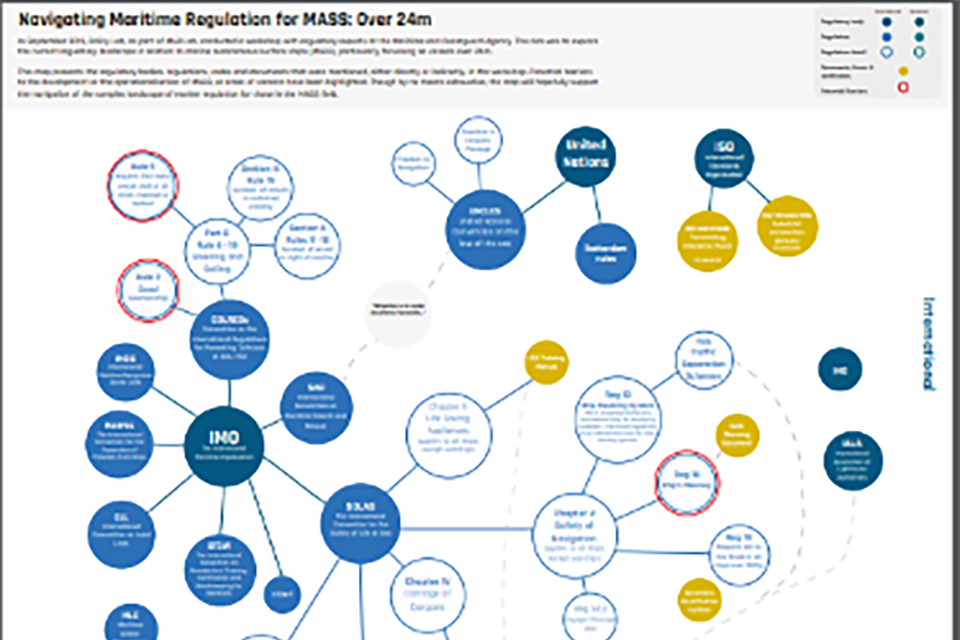
Regulatory map example
Figure 3: Example of a regulatory map
One of the initial plans for MARLab was to establish a regulatory sandbox. During the co-creation day with Policy Lab we agreed on the need for innovative toolkit, similar to a sandbox, in which policy leads could test regulatory proposals with industry. Using serious gaming techniques, Policy Lab designed a desktop- scenario toolkit that MCA can use to explore and test complex regulatory proposals with industry in a holistic way.
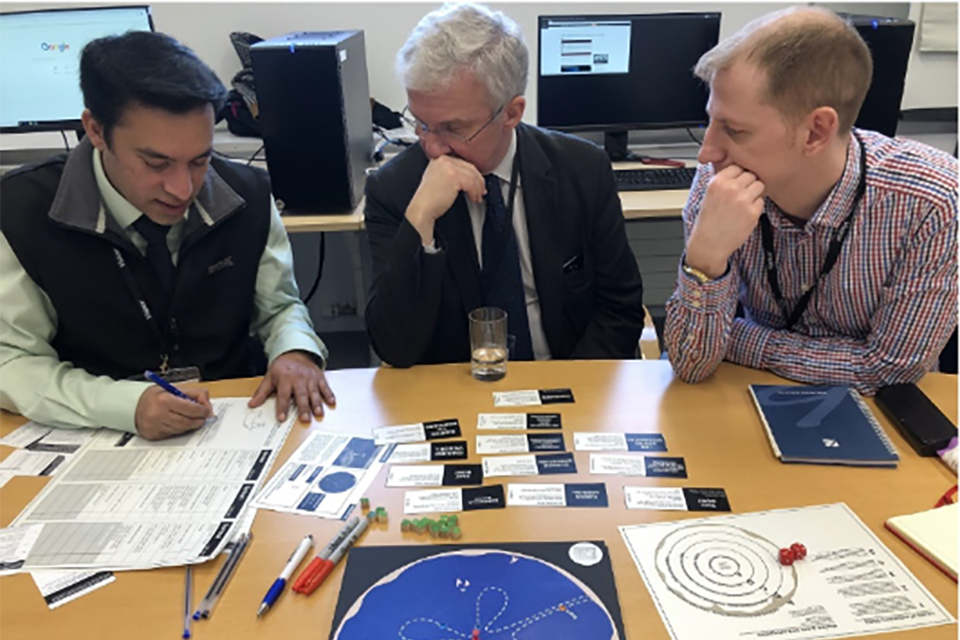
Stakeholders in attendance at regulatory workshop
Figure 4: Regulatory workshop toolkit used during first trial with MCA
Working in teams, participants design a vessel to complete a proposed voyage (or mission). The design of the vessel will be approved, based on a checklist including current and proposed regulations. The teams “go on” the voyage during which they are presented with “risks” which act as a mechanism for discussing regulatory proposals and developments within autonomy. This approach was stress tested with MARLab and MCA colleagues and revised. Unfortunately, the 2020 pandemic meant our plans to run workshops with industry have been put on hold. We plan to use this as part of our stakeholder engagement when revising the Workboat Code. This tool will allow us to engage with industry in an interactive manner, and provide a holistic review of regulations rather than line by line potentially siloed approach.
Using the design skills and innovative approaches of the Policy Lab, an additional piece of work was commissioned to develop an animation to summarise and promote the work of MARLab. This will be used as part of showcasing all the outcomes of MARLab.
6.2 National Oceanography Centre (NOC)
The National Oceanography Centre, known for their expertise and experience with Autonomous Underwater Vehicles (AUV) and in more recent years, Autonomous Surface Vehicles (ASV) have been leading on the operational and legal review of existing legislation, starting with the Merchant Shipping Act 1995, and later moving onto review the Workboat Code, version 2.
They set up and managed a Project Advisory Board (PAB) that included a team of four specialists in Maritime Law and Maritime Operations, and two experts from NOC with experience of using MASS. The team were tasked with reviewing the Merchant Shipping Act (1995) to determine whether the Act imposed barriers to the operation of MASS under 24 metres, and identify gaps that needed addressing for MASS trials and operation to take place in UK waters. The team also reviewed the Act to determine whether there were aspects of the Act which might benefit from clarification for MASS operators.
From its interpretation and discussion, the PAB concluded, that no provisions in the Merchant Shipping Act expressly prohibit MASS operations. However, the group did identify a number of provisions in the Act that are vague in nature and it is thus unclear whether they raise compliance issues for MASS. The areas that would benefit from clarification including definitions such as Master and Seafarer, other aspects requiring further investigation include: Roles and Responsibilities, Manning Levels, Training, and Remote Operation facilities and requirements. The next steps will be to review the Statutory Instruments that provide the detailed requirements for these areas, as a starting point the MARLab identified and reviewed four key Statutory Instruments in detail[footnote 1]. These reviews provided us with more detailed understanding of the limitations and complexities of the current regulation, for example manning levels are not simply the number of people onboard but also the competencies of individuals. The report produced by NOC provides us with the links to other regulations that need to be considered to address these matters and gives us the information to start production conversations about making the regulations work for this innovative industry.
The work of Policy Lab and NOC have allowed the MCA to start reviewing the Workboat Code and address gaps and barriers to allow for the remote operation of vessels. As part of this the NOC team have provided support reviewing specific Statutory Instruments (SIs) referenced in this Code, and our next steps are to engage in a broader review of SIs and the Merchant Shipping Act to identify barriers for the larger vessels that are beginning to be discussed in the UK MASS industry. With all these reviews we are able to start amending regulation, such as the Workboat Code to support industry in their testing and operation of MASS in UK waters.
6.3 Solis Marine Consultants
The final area of work for MARLab was the data workstream led by Solis Marine Consultants to address the issues MASS manufacturers and operators face in sourcing assured data to support safe operation of autonomous craft. Solis Marine embarked on a nationwide consultation via questionnaires and follow-up interviews with industry stakeholders and academia to establish how government data could support industry. With this information they developed a data platform (a minimum viable product – MVP providing access to data for a limited geographical area (Portland Harbour) to enable industry users to utilise the data and provide feedback to Solis Marine [footnote 2]. The platform was developed to be user friendly and provide data in API format for industry to “plug in” to their own software or developments. As well as providing MCA AIS data, Solis Marine identified and sourced data the MASS industry noted would assist developments, including UKHO bathymetry data, MET Office weather data as well as local port movements data. After a period of six months users of the portal were interviewed to identify the pros and cons of the portal and the ways in which the data would be used, which Solis Marine produced as an internal report for the MCA.
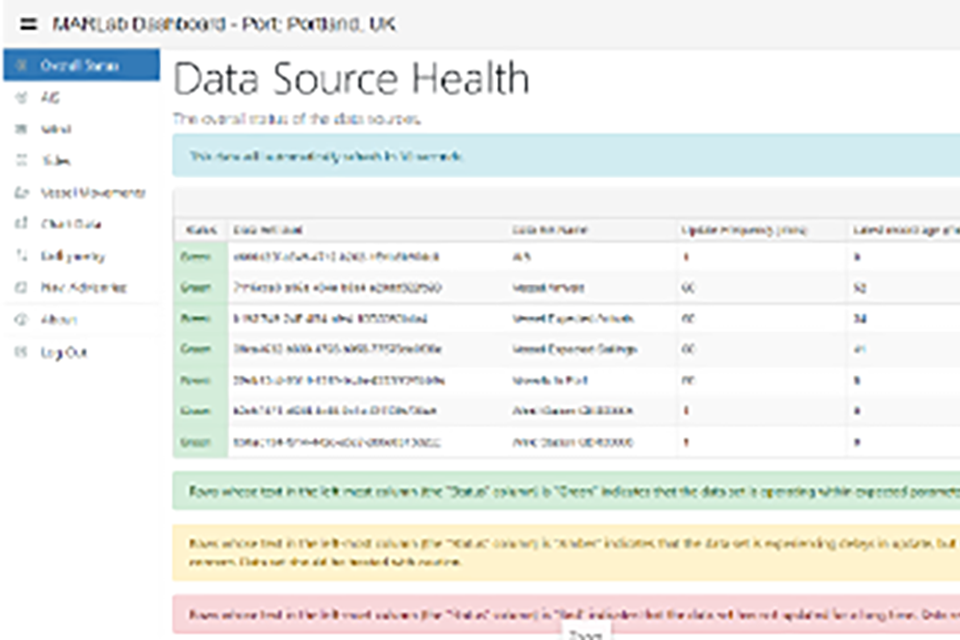
Example of the MARLab data portal
Figure 6: MARLab Data Portal
The key findings from this report highlighted there is industry appetite for an accessible data platform, data from assured sources, and that the real value would lie with extending the portal to cover the ‘whole of the UK’. Results of the interviews stated the four top data sets industry requested were AIS data, tidal data, UKHO geospatial data and a hydrographic model of UK waters. Alongside highlighting the data industry also asked for a demonstration of best practice guidelines for data use and for MCA to provide clarity and leadership.

MARLab data portal extract
Figure 7: Extract from SOLIS Final Report showing heatmap visualisation of vessel movements based on AIS data
At the end of the project the MCA carefully reviewed the findings from the data workstream and identified that retaining the portal is beyond the remit of the MCA’s regulatory scope. However, the MCA will take steps to ensure that its own AIS data, for example, is available in a format that support industry should such a portal be developed commercially. We will also continue to work with both the UKHO and Met Office regarding data needs of MASS, especially where these could have safety implications. This research did highlight the importance of data for MASS but also the cross-cutting nature of data both in terms of where it is sourced and the complexities in ability to support the industry in terms of data.
7. Future of MARLab
The next steps for MARLab are linked to the newly formed Maritime Future Technologies (MFT) team. Building on the work of the MARLab project, the Maritime Future Technologies (MFT) team has been established by the MCA to facilitate the implementation of trials and projects, support regulatory updates and drive forward change in industry in the uptake of innovative technologies in both Emission Reduction and Autonomy.
The MCA, are looking at adjacent markets to understand how other regulators in these sectors approach Autonomy regulation, i.e. the Automotive, Aerospace, Manufacturing, Mining industries all utilise autonomy in many forms to increase productivity and operations and decrease unnecessary costs to the business.
One such area we are looking into is Civil Aerospace – Beyond Visual Line of Sight (BVLOS) un-segregated airspace. MCA has engaged with a University of Southampton PhD student whose focus will be:
- Gaining and understanding of approach that is being undertaken in the civil aviation industry in regulating unmanned air systems, and provide high level summary
- Gaining and understanding of what is being done from a maritime perspective to regulating unmanned systems and provide high level summary
- Draw out parallels that could be considered from the civil aerospace sector into the maritime sector and vice versa (from a regulatory perspective)
- Provide interface and cross learning between the two areas within the MCA.
The above workstream represents one of a further nine that the team are facilitating: the implementation of trials and projects, support for regulatory updates and ultimately driving forward change.
Building on the stakeholder relationships identified by Policy Lab (and as part of the work of all MARLab partners) MFT has appointed stakeholder managers who are developing collaboration opportunities and engagement with Industry (such as Fugro), Academia (such as University of Southampton) and across Government (such as Met Office and Civil Aviation Authority).
The ‘MARLab’ brand, which has been embraced by industry, will transition to Maritime Future Technologies where all the work is fully embedded. MFT will be the interface between MCA and industry for specific projects, providing the facilitation and support elements to ensure UK MASS industry are able to successfully get their projects on the water with suitable certification. Examples of how the MARLab project supported industry projects can be found in Annex A. The regulatory developments required for MASS to operate in the UK, further work to consider and address legal barriers for larger and fully autonomous vessels, and engagement with the wide range of stakeholders now form the day to day business of the MFT team.
8. MARLab Conclusions
The Regulators’ Pioneer Funded project for MARLab came to an end in June 2020 after a short extension due to the covid-19 pandemic.
The project has provided lessons learnt as well as positives. An early lesson learnt was that internal procurement processes take time and are not always compatible with being awarded grants such as the RPF, which led to some initial difficulties in spending the funds. Not all the workstreams developed in the way we expected, for example the data workstream presented data access challenges (the MCA will now work to ensure data can be made available more easily such as AIS to support industry). It was also ok for the workstream to not be taken further, it provided us with useful information that has guided us, but it was right to acknowledge that future steps are outside our remit.
We have learnt to be ambitious, take a risk; it is ok to not know the exact direction of the project the whole time, an agile approach was necessary. For example, we needed the initial outcomes from Policy Lab (stakeholder network and regulatory maps, and evidence discovery cards) so we could have an informed discussion about where regulatory review needed to take place and what innovative approaches we could possibly take towards regulation. But this approach left us feeling a little in limbo mid-way through not knowing exactly what the next steps for Policy Lab and NOC could be; with hindsight it worked out well.
In terms of positives, we have a significantly better understanding of who is in the UK MASS industry, what they are doing, and have encouraged them to engage more pro-actively with the MCA. The appointment of Stakeholder Managers means we can continue to develop these relationships as this industry grows. As well engaging with industry MCA will look to continue engagement with the MARLab partners, such as continuing partnership at the NOC’s Marine Robotics Innovation Centre. We now have evidence that confirms the complexity of MASS with the range of vessels (size and purpose of operation) and nuances in regulations that need to be addressed (definitions, clarity of responsibilities, carriage of documentation). These highlight that whilst we are still learning about MASS, ‘one size does not fit all’ and our immediate approach to testing and trialing MASS will continue a case-by-case approach. However, as our understanding improves, we will be able to formalize regulatory changes. For example, with the information we have gained through the Policy Lab and NOC on operations and the legal barriers we are able to begin amending regulations for a very specific area of MASS, that is remotely operated vessels under 24m in length.
Our approach to engaging with stakeholders as we test proposed regulations for this complex area will change. We will use the Regulatory Workshop tools developed by Policy Lab (as detailed above) and hope to promote these as a way of engaging industry in a more holistic discussion about regulation this area of innovation. The tools will be used internally by MFT, although the toolkit has been written specifically for autonomy, slight alterations to the scenarios, risks and checklists could make this a useful tool for other policy areas initially within the maritime sector. Even as we use the toolkit amendments will need to be made so the checklist reflects our proposed regulations.
All expected deliverables were met except for running the Policy Lab regulation workshop with industry (all tools and resources were completed and ready for production) and a public showcase demonstrating the outcomes of MARLab. Both were postponed due to covid-19 restrictions that start in March 2020. The Policy Lab tools will be used as part of stakeholder engagement during the review of the Workboat code, though it may require some digital outside-the-box thinking. A showcase of MARLab will also take place virtually as part of NOC’s Marine Autonomous Technology Showcase in November 2020. We are finalizing the details of how the showcase will be presented and the final location of the deliverables from this project, whether that is internal use only or publicly available on the government website. The following were completed as part of MARLab:
- Two Regulatory Network Maps
- Interactive MASS Stakeholder Network Map
- Evidence Discovery Cards Pack (analyzing results of 40 interviews)
- Co-Creation Day tools (facilitation resources including pack of regulation cards)
- Regulatory Workshop toolkit: Board, Scenarios, Approver Checklist, Risks, Rules, Vessel Design Assessment.
- Project Advisory Board Report: Review of Merchant Shipping Act, 1995
- Project Advisory Board Extension Report: Key Statutory Instrument Review
- Report on the Workboat Code related Statutory Instrument Review
- MARLab online Portal
- MARLab Portal Report
- Data Workstream Gap Analysis Report
- Data Workstream: Final Report (Confidential to the MCA)
- MARLab Animation
These deliverables have all helped the MCA develop the future work needed to support the MASS industry in the UK, and will continue to be developed by MFT. Support from the Regulators’ Pioneer Fund has allowed us to accelerate our exploration in maritime autonomy.
9. Annex A: Industry Projects
MCA’s remit is to ensure that all MASS activities are regulated appropriately to ensure safe and successful trials and operations, and want to encourage industry to test in UK Waters. MARLab engaged with companies at various stages from design concept through to the vessel being ready to hit the water. Once engaged MARLab worked continually with them to ensure their vessel, the operations and their overall mission is fit for purpose in terms of meeting regulatory requirements. This included facilitation between companies and MCA policy leads, advice on the process to follow, and supporting policy leads internally on the best way to support these projects by providing context of MASS operations and other vessel developments.
9.1 USV Maxlimer
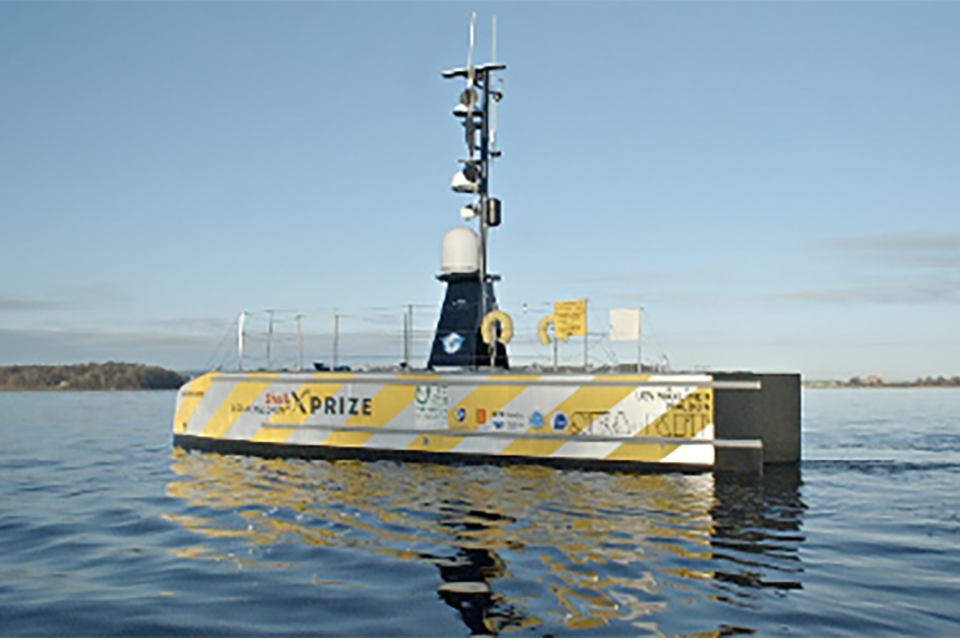
Seakit
USV Maxlimer at sea (image credit: Sea-Kit)
In May 2019 SEA-KIT International sailed USV Maxlimer, its unmanned remotely operated vessel from Mersea, UK to Oostende, Belgium, carrying a box of oysters and returning with Belgium beer. The trial was designed to showcase SEA-KIT’s unmanned navigation capabilities through GPS and satellite communication, including traversing one of the world’s busiest shipping routes. The Global Situational Awareness via Internet (G-SAVI) communications and control system allowed an operator to remotely access CCTV footage, thermal imaging and radar through SEA-KIT, as well as listen live to the vessel’s surroundings and communicate with others in the vicinity. MARLab helped by providing additional advice and guidance to SEA-KIT, to ensure they understood the legal requirements and were able to obtain the exemption required for this operation.
In July 2020, SEA-KIT undertook an unmanned Trans-Atlantic Survey in conjunction with the European Space Agency (ESA) to demonstrate the capabilities of remotely operated vessels to survey unexplored parts of the ocean floor for extended periods of time. Previous advice MARLab provided SEA-KIT with the confidence to undertake the voyage, and for this project MARLab was providing advice internally where different MCA surveyors were involved in the exemptions process. The vessel undertook the voyage and was at sea for 22 days, one of the longer remote operations
9.2 XOcean
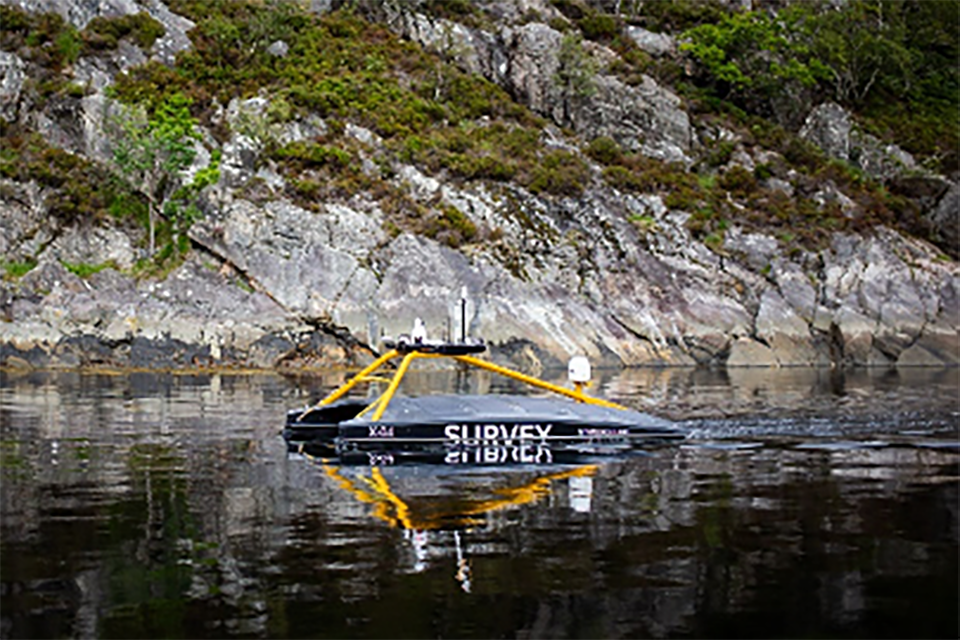
XOcean
XOcean remotely operated vessel (image credit: XOcean)
In 2018 XOcean started using small remotely operated vessels as part of the Civil Hydrography Programme (CHP) working for Meritito, a hydrography survey company contracted for part of the CHP. Our initial involvement was limited as MARLab was established as this work was commencing, however MARLab was able to work with XOcean to better understand how vessels were operated. These vessels continue to be issued with appropriate exemptions and MARLab advice has been internally to ensure consistency with MCA surveyors.
9.3 Mayflower
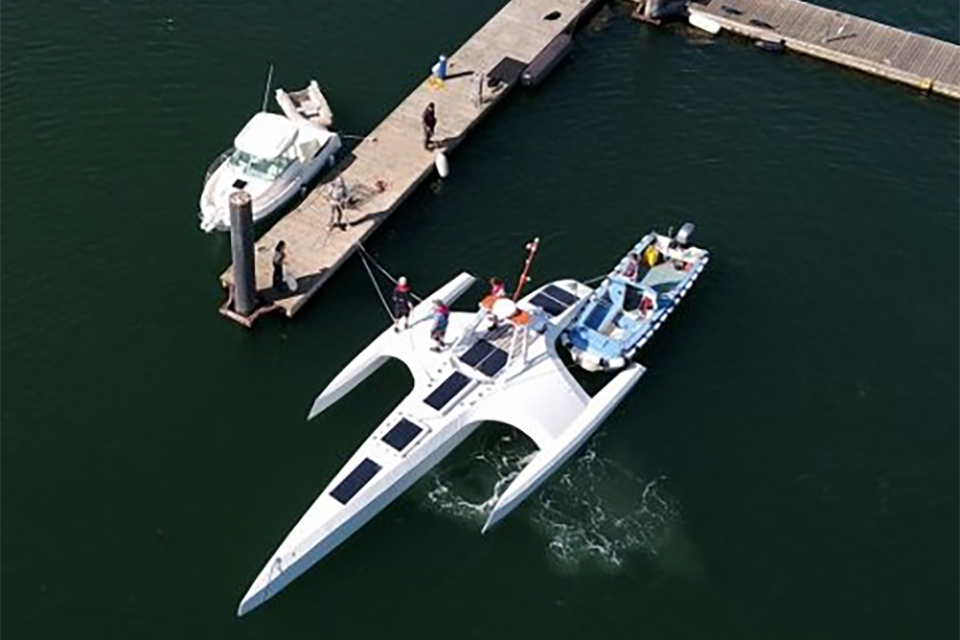
MSUBS
Mayflower 400 autonomous surface ship (image credit: MSUBS)
On 16 Sept 2020 Mayflower 400 was named and launched, the vessel is an autonomous surface ships s that will cross the Atlantic from Plymouth UK to Plymouth Massachusetts, recreating the pilgrim’s voyage to America on its 400th Anniversary. The project which begun in 2014 is a collaboration between MSubs, Plymouth University, ProMare and IBM. MSubs aspiration is that the Mayflower Autonomous ship will carry a research pod with sensors and other equipment which will enable research into ocean conditions, marine pollution and conservation, and autonomous navigation.
9.4 Anglo Belgian Shipping Company
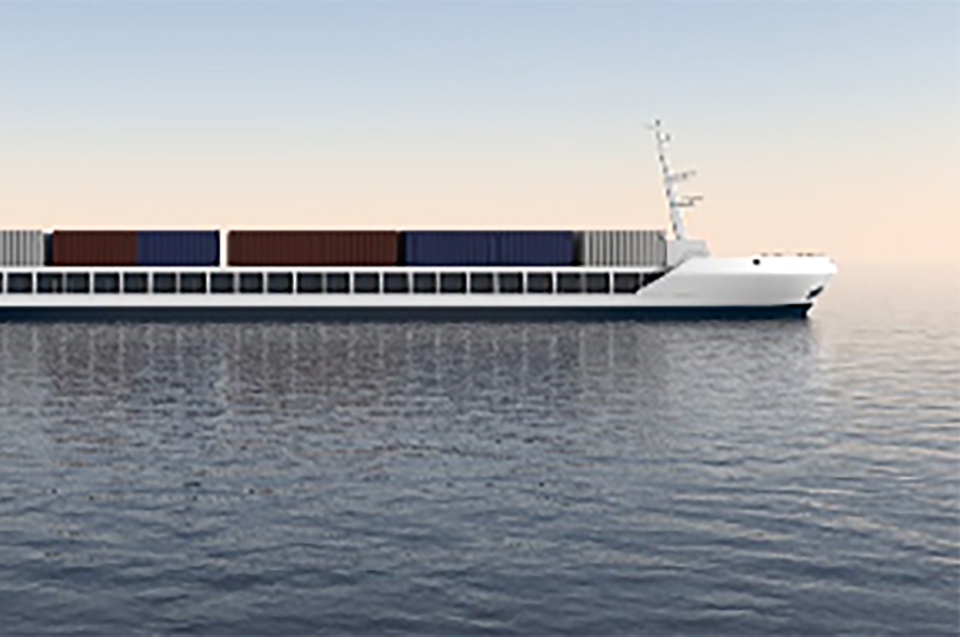
Anglo Belgian Shipping Company
Mockup of short-sea shipping container vessel (image credit: Anglo Belgian Shipping Company)
Working with ABSC in the very early stages of concept design, MARLab has been able to support and facilitate international discussions regarding a proposal for short-sea shipping container vessel that could operate between the UK, Netherlands and Belgian. Though in the early stages projects such as these allow MARLab to develop important international collaborations.
9.5 ARMADA

Ocean Infinity
Mockup of ARMADA autonomous surface ships (image credit: Ocean Infinity)
MCA knows only too well this industry is moving at pace and the vessel sizes are getting bigger, i.e. over 24m. Ocean Infinity launched ARMADA in Feb 2020 proposing a fleet of 15 autonomous surface ships, with a focus on combining technology and sustainability. The aspiration is that each unmanned surface vessel will be fully equipped to carry out offshore data and intervention operations down to depths of 6,000 meters. MARLab is working with Armada with regular meetings to facilitate discussions between the Armada team and MCA policy leads, as well as identifying the legal requirements that need to be addressed as plans for larger vessels are proposed. This is an example where MARLab and MFT will continue to work closely with Armada as their plans present new challenges to the MCA as a regulator, in terms of the size of vessel, and range of regulations it will impact. Our engagement with the Armada team is to ensure their readiness for deployment.
-
Merchant Shipping (Small Workboats and Pilot Boats) Regulations SI 1998/1609; Merchant Shipping (Standards of Training, Certification and Watch keeping) Regulations 2015, SI 2015/782; Merchant Shipping (Distress Signals and Prevention of Collisions) Regulations 1996, SI 1996/75; Merchant Shipping (Safety of Navigation) Regulations 2002, SI 2002/1473. ↩
-
A video demonstrating how the MARLab portal was used can be accessed via https://youtu.be/O9kITcubmgU ↩
